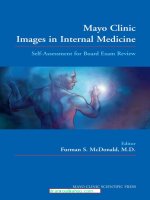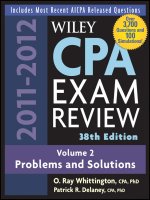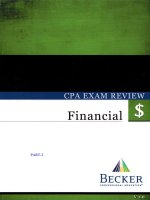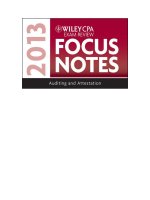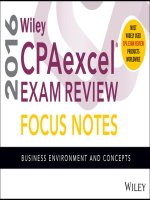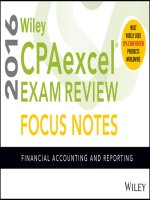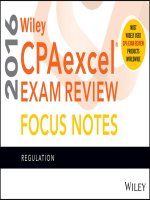CPA wiley auditing exam review 2013
Bạn đang xem bản rút gọn của tài liệu. Xem và tải ngay bản đầy đủ của tài liệu tại đây (627.09 KB, 88 trang )
CONTENTS
Preface
About the Author
About the Contributor
Professional Responsibilities — Module 1
Code of Professional Responsibilities
Engagement Planning, Obtaining an Understanding, and Assessing Risks —
Module 2
Understanding Internal Control and Assessing Control Risk — Module 3
Consideration of Internal Control
Responding to Risk Assessment: Evidence Accumulation and Evaluation —
Module 4
Sufficient Appropriate Audit Evidence
Reporting — Module 5
Audit Reports
Other Engagements & Reports
Accounting and Review Services — Module 6
Accounting and Review Services
Audit Sampling — Module 7
Sampling
Auditing with Technology — Module 8
Responsibilities in An Information Technology Environment
Index
Copyright © 2013 by John Wiley & Sons, Inc. All rights reserved.
Published by John Wiley & Sons, Inc., Hoboken, New Jersey
Published simultaneously in Canada.
No part of this publication may be reproduced, stored in a retrieval system or
transmitted in any form or by any means, electronic, mechanical, photocopying,
recording, scanning or otherwise, except as permitted under Section 107 or 108 of the
1976 United States Copyright Act, without either the prior written permission of the
Publisher, or authorization through payment of the appropriate per-copy fee to the
Copyright Clearance Center, Inc., 222 Rosewood Drive, Danvers, MA 01923,
978-750-8400, fax 978-750-4470, or on the Web at www.copyright.com. Requests to the
Publisher for permission should be addressed to the Permissions Department, John Wiley
& Sons, Inc., 111 River Street, Hoboken, NJ 07030, 201-748-6011, fax 201-748-6008, or
online at />Limit of Liability/Disclaimer of Warranty: While the publisher and author have
used their best efforts in preparing this book, they make no representations or warranties
with respect to the accuracy or completeness of the contents of this book and specifically
disclaim any implied warranties of merchantability or fitness for a particular purpose. No
warranty may be created or extended by sales representatives or written sales materials.
The advice and strategies contained herein may not be suitable for your situation. You
should consult with a professional where appropriate. Neither the publisher nor author
shall be liable for any loss of profit or any other commercial damages, including but not
limited to special, incidental, consequential, or other damages.
For general information on our other products and services, or technical support,
please contact our Customer Care Department within the United States at 800-762-2974,
outside the United States at 317-572-3993 or fax 317-573-4002.
Wiley also publishes its books in a variety of electronic formats. Some content
that appears in print may not be available in electronic books. For more information
about Wiley products, visit our Web site at .
ISBN: 978-1-118-41057-8 (paperback); 978-1-118-60794-7 (ebk);
978-1-118-60780-0 (ebk); 978-1-118-60768-8 (ebk)
PREFACE
This publication is a comprehensive, yet simplified study program. It provides a
review of all the basic skills and concepts tested on the CPA exam and teaches important
strategies to take the exam faster and more accurately. This tool allows you to take
control of the CPA exam.
This simplified and focused approach to studying for the CPA exam can be used:
As a handy and convenient reference manual
To solve exam questions
To reinforce material being studied
Included is all of the information necessary to obtain a passing score on the CPA
exam in a concise and easy-to-use format. Due to the wide variety of information covered
on the exam, a number of techniques are included:
Acronyms and mnemonics to help candidates learn and remember a variety of
rules and checklists
Formulas and equations that simplify complex calculations required on the exam
Simplified outlines of key concepts without the details that encumber or distract
from learning the essential elements
Techniques that can be applied to problem solving or essay writing, such as
preparing a multiple-step income statement, determining who will prevail in a legal
conflict, or developing an audit program
Pro forma statements, reports, and schedules that make it easy to prepare these
items by simply filling in the blanks
Proven techniques to help you become a smarter, sharper, and more accurate test
taker
This publication may also be useful to university students enrolled in Intermediate,
Advanced and Cost Accounting; Auditing, Business Law, and Federal Income Tax
classes; Economics, and Finance Classes.
Good Luck on the Exam,
Ray Whittington, PhD, CPA
ABOUT THE AUTHOR
Ray Whittington, PhD, CPA, CMA, CIA, is the dean of the Driehaus College of
Business at DePaul University. Prior to joining the faculty at DePaul, Professor
Whittington was the Director of Accountancy at San Diego State University. From 1989
through 1991, he was the Director of Auditing Research for the American Institute of
Certified Public Accountants (AICPA), and he previously was on the audit staff of
KPMG. He previously served as a member of the Auditing Standards Board of the
AICPA and as a member of the Accounting and Review Services Committee and the
Board of Regents of the Institute of Internal Auditors. Professor Whittington has
published numerous textbooks, articles, monographs, and continuing education courses.
ABOUT THE CONTRIBUTOR
Kurt Pany, PhD, CPA, is a Professor of Accounting at Arizona State University.
His basic and advanced auditing courses provided the basis on which he received the
Arizona Society of CPA’s Excellence in Teaching Award and an Arizona CPA
Foundation Award for Innovation in the Classroom for the integration of computer and
professional ethics applications. His professional experience includes serving for four
years on the AICPA’s Auditing Standards Board, serving as an academic fellow in the
Auditing Division of the AICPA, and prior to entering academe, working as a staff
auditor for Deloitte and Touche.
Professional Responsibilities — Module 1
Summary of the 10 Generally Accepted Auditing Standards (GAAS)
T—Training and Proficiency I—Independence P—Professional Care P—Planning and
Supervision I—Internal Control E—Audit Evidence G—Generally Accepted Accounting
Principles O—Opinion D—Disclosures C—Consistency The Standards spell out TIP,
PIE, and GODC (the reporting standards are ordered 1, 4, 3, 2 for GOD and a soft-c to
sound like gods)
General Standards (3)
1) Training and proficiency. The auditor must have adequate technical
training and proficiency to perform the audit. 2) Independence. The
auditor must maintain independence in mental attitude in all matters
relating to the audit. 3) Professional care. The auditor must exercise due
professional care in the performance of the audit and the preparation of
the report. Standards of Fieldwork (3)
1) Planning and supervision. The auditor must adequately plan the work
and must properly supervise any assistants. 2) Internal control. The
auditor must obtain a sufficient understanding of the entity and its
environment, including its internal control, to assess the risk of material
misstatement of the financial statements whether due to error or fraud,
to design the nature, timing and extent of further audit procedures. 3)
Audit evidence. The auditor must obtain sufficient appropriate audit
evidence by performing audit procedures to afford a reasonable basis
for an opinion regarding the financial statements under audit.
Standards of Reporting (4)
1) GAAP. The auditor must state in the auditor’s report
whether the financial statements are presented in accordance
with generally accepted accounting principles (GAAP). 2)
Consistency. The auditor must identify in the auditor’s report
those circumstances in which such principles have not been
consistently observed in the current period in relation to the
preceding period. 3) Disclosures. When the auditor determines
that informative disclosures are not adequate, the auditor must
so state in the auditor’s report. 4) Opinion. The auditor must
either express an opinion regarding the financial statements,
taken as a whole, or state that an opinion cannot be expressed,
in the auditor’s report. When the auditor cannot express an
overall opinion, the auditor should state the reasons therefor in
the auditor’s report. In all cases where an auditor’s name is
associated with financial statements, the auditor should clearly
indicate the character of the auditor’s work, if any, and the
degree of responsibility the auditor is taking, in the auditor’s
report. CODE OF PROFESSIONAL RESPONSIBILITIES
AICPA
General Standards & Accounting Principles
A CPA must perform with competence and must exercise due care
Competence implies combination of education & experience
Due care includes proper supervision & reviewing work of assistants
Examples of actions that would violate the standard of due care include
Performing professional services without complying with the appropriate standards
Expressing an unqualified opinion on financial statements known to be materially
misstated Failing to report the discovery of fraud to the client’s audit committee
Independence – Covered members
The concept of covered members is important since certain independence
requirements apply to them. Included as “covered members” are:
A member of the attest engagement team.
A person who may influence the attest engagement.
A partner in the office in which the lead attest partner practices.
The firm, including its benefit plans.
A member in public practice shall be independent in the performance of
professional responsibilities
Independence impaired if a covered member Had committed to acquire any direct
or material indirect financial interest in the client. Was a trustee or executor or estate that
had/committed to acquire any direct or material indirect financial interest in the client in
excess of 10% of assets. Had a material joint closely held investment. Had a loan to or
from the client, officer, director of the client, or any individual owning 10% or more of
client’s capital (there are some exceptions to this).
Partner or professional employee of the firm, his or her immediate family owned
more than 5% of capital
Was associated with the client as a(n) Director, officer, or employee, or in any
capacity equivalent to that of a member of management; Promoter, underwriter, or voting
trustee
Independence impaired by Supervising client’s personnel Signing client’s checks
Acting as client’s stock transfer agent Entering into lease with client Accepting gifts from
client Obtaining material loan from client, even if fully collateralized (except by cash
balances)
Independence – Effect on Independence of Family Members, Relatives
and Friends
Overall: These groups may impair a CPA’s independence.
General Rules:
Immediate family (spouse, spousal equivalent or dependent): Restrictions
generally same as for accountant. Exceptions relate to those in other than a key position
with a client and certain benefit plans.
Close relatives (parent, sibling, or nondependent child): Independence not
impaired unless close relative has a key position with client or a material financial
interest of which the accountant is aware.
Other relatives and friends: Independence not impaired unless a reasonable
person aware of the facts would conclude there is an unacceptable risk.
Independence – Unpaid Fees
Unpaid fees may impair independence. May not extend beyond one year Audit
may be performed, but report may not be issued until prior year fees paid
Independence - Auditor Takes Employment with Audit Client
Must inform the audit firm
If enter into negotiations must be immediately removed from the engagement and
all their work reviewed by the audit firm
Once accepts employment with audit client, the audit firm should consider the
need to modify the audit plan or change members of the audit
In any audit performed within a year of the professional joining the client, a
member of the audit firm with no connection to the audit must review all work to ensure
it takes into account independence issues
When performing certain services, CPA must be independent in fact and in
appearance. Independence in fact means No direct or material indirect financial interest
in client Independence is impaired if a CPA takes on a decision-making role for an audit
client Independence is not impaired if a CPA performs litigation support services for a
client
Independence - Nonattest Services
May provide advice, research materials, and recommendations
Client must accept responsibility for making all decisions
Specific client personnel must be designated to oversee services
Client must be responsible for establishing and maintaining all internal controls
and may not “outsource” such services to the auditor
An understanding of the objectives of the engagement and client responsibilities
must be documented prior to performing the nonattest services for an attest client
A member shall maintain objectivity and integrity, shall be free of conflicts of
interest, and shall not knowingly misrepresent facts or subordinate his or her judgment to
others.
Misrepresentation of facts: Member is forbidden to knowingly (or let someone
else) Make materially false and misleading entries Fail to correct financial statements or
records that are materially false and misleading Sign a document containing materially
false and misleading information
A conflict of interest may exist if member performing a service and the
member/member’s firm has a relationship that could in the member’s judgment, be
viewed as impairing the member’s objectivity. For example, Suggest that the client invest
in a business in which he or she has a financial interest. Provide tax services for several
members of a family who may have opposing interests. Have a significant financial
interest or influence with a major competitor of a client.
Obligations of a member to his or her employer’s external accountant Must be
candid and not knowingly misrepresent facts or knowingly fail to disclose material facts
Responsibilities to Clients
A member in public practice shall not
Disclose any confidential client information without the specific consent of the
client
Accept a contingent fee for An audit or review of a financial statement A
compilation of a financial statement An examination of prospective financial information
Prepare an original or amended tax return or claim for a tax refund for a
contingent fee for any client
A CPA must maintain client information as confidential. May disclose client
information to
Comply with a subpoena
Cooperate with a quality control review
Other Responsibilities & Practices
A CPA should not perform acts discreditable to the profession, such as
Retaining client records
Understating anticipated fees for services
Accepting a commission in relation to an attest client
Practice under a misleading name
A CPA shall be competent
Agreeing to perform professional services implies that the member has the
necessary competence to complete those professional services but is not infallible
Involves both the technical qualifications of the member and staff and the ability
to supervise and evaluate the quality of the work performed
If the member does not have the necessary competence, may perform additional
research or consult with others
But if cannot attain competence, should recommend client seek help from
someone else
Tax Preparer
Actions by an accountant preparing a client’s tax return can result in penalties for
Not providing client with copy of return
Failing to sign return as a preparer
Endorsing & cashing client’s refund check
Failing to file a timely return
Not advising client of tax elections
Neglecting evaluation of joint versus separate returns
A CPA performing tax services
May not recommend a tax position that lacks merit
Must make a reasonable effort to answer applicable questions on the return
May rely on client information when preparing the return
Must make reasonable inquiries about questionable or incomplete information
May use estimates
Standards for Consulting Services
When performing consulting services, a CPA must adhere to certain general
standards
Professional competence
Due professional care
Planning & supervision
Obtaining sufficient relevant data
GAO Code of Ethics
Federal auditors, or CPA firms auditing federal dollars, should not perform
management functions or make management decisions.
Federal auditors, or CPA firms auditing federal dollars, should not audit their own
work.
Federal auditors, or CPA firms auditing federal dollars, should not provide
nonaudit services that are material to the subject matter of an audit.
Emphasis:
Accountability of government officials to the Congress
Accountability of the auditor to conduct work professionally
No requirement to evaluate management controls
Executive leadership of the audited agencies is not the primary customer
Mgt input not solicited as part of the audit process
Mgt input not solicited in development of solutions
Mgt is presented with “findings” to which it must “respond”
Institute of Internal Auditors Code of Ethics
The IIA Standards focus on improvement of risk management, control and
governance processes within an organization so that issues of concern can be identified
and corrected before they become persistent or pervasive problems.
Mandate organizational independence of the audit department and mandate
individual auditor objectivity. Internal auditors (IA) must report to a level within the
organization that permits the audit department to fulfill its responsibilities. IA must not
perform management functions or make management decisions. IA must not audit their
own work. IA must determine the nature and scope of their work.
Sarbanes-Oxley Act
Regulation S-K requires companies to disclose:
Whether they have a written code of ethics that applies to their CEO, CFO,
Controller, or persons performing similar functions
Any waivers of the code of ethics for these individuals
Any changes to the code of ethics
Code must be designed to promote:
Honest and ethical conduct, including the ethical handling of actual or apparent
conflicts of interest
Full, fair, accurate, timely, and understandable disclosure in company filings and
publications
Compliance with applicable governmental laws, rules and regulations
Prompt internal reporting of violations of the code to the appropriate person or
persons identified
Accountability for adherence to the code
Audit committee (AC) responsible for the appointment, compensation, and
oversight of audit firm
Each member of the AC is a member of the board of directors and independent
One financial expert required on AC
AC reports directly to Board
CEO and CFO must certify accuracy and truthfulness of financial statements
Civil ($5,000,000) and criminal (10 years) liability
Any person who knowingly attempts to or commits fraud in sale of securities has
civil and criminal liability (up to 25 years)
International Ethics Standards
The International Ethics Standards Board for Accountants (IESBA) is a
standard-setting body within the International Federation of Accountants (IFAC) that
issues ethical standards for accountants throughout the world. The IESB Framework
applies to all professional accountants
Integrity
Objectivity
Professional competence and due care
Confidentiality
Professional behavior
Department of Labor Independence Requirements for Employee
Benefit Plans
An accountant is not independent with respect to the plan if he/she
Has direct financial interest or any material indirect financial interest in the plan
or plan sponsor
Is a promoter, underwriter, investment advisor, voting trustee, director, officer, or
employee of the plan
Maintains financial records for the employee benefit plan
International Auditing and Assurance Standards
International auditing standards are developed by the International Auditing and
Assurance Standards Board (lAASB) of the International Federation of Accountants
(IFAC)
International standards do not require an audit of internal control, while PCAOB
standards do so require
International standards do not allow reference to another audit firm involved in a
portion of the audit
International standards for documentation are less detailed than PCAOB standards,
leaving more to professional judgment
International standards in the area of going concern include a time horizon of at
least, but not limited to, twelve months
International standards are based on a risk assessment of effectiveness of quality
control policies & procedures
Engagement Planning, Obtaining an Understanding and
Assessing Risks — Module 2
Financial Statement Assertions
Management’s responsibility
Assertions themselves
Transaction Classes Account Balances Disclosures Occurrence Existence
Occurrence Rights and obligations Rights and obligations Completeness
Completeness Completeness Accuracy Valuation and allocation Valuation
and accuracy Cutoff Classification Classification and
understandability Audit Risk (AR)
AR is risk that material errors or fraud exists resulting in an inappropriate audit
report
Auditor uses judgment in establishing acceptable level of AR
Lower acceptable level of AR achieved through obtaining more audit evidence
AR consists of inherent risk (IR), control risk (CR), & detection risk (DR)
IR acknowledges that certain items are more susceptible to risk
May be due to complexity of transactions or calculations, ease of theft, or lack of
available objective information
IR is beyond control of auditor & generally beyond control of entity
CR acknowledges that misstatements may not be prevented or detected by
entity’s internal control
Entity’s internal control may be poorly designed or poorly executed
CR is beyond control of auditor but within control of entity
The combination of IR and CR is referred to as the “risk of material
misstatement”
DR acknowledges that auditor may not detect material misstatement
Auditor may not properly plan audit procedures
DR is within control of auditor
Components of Audit Risk
Increases risk Decreases risk Inherent risk Declining industry
Lack of working capital
High rate of obsolescence More profitable than industry average
Low management turnover Control risk Ineffective internal controls
Weak management oversight Effective internal control
Strong management oversight Detection risk Decrease substantive testing
Perform tests early in year Increase extent of substantive procedures
Select more effective tests
Perform tests near year-end Applying Audit Risk Model
AR = IR × CR × DR
To apply model
Establish acceptable level of audit risk
Measure inherent risk based on internal & external factors
Establish planned assessed level of control risk based on discussing internal
control with management
May set control risk at maximum level
If control risk set below maximum, must perform tests of controls to verify
assessment
Compute necessary level of detection risk
DR = AR ÷(IR × CR)
Determine if planned nature, timing, & extent of substantive tests are adequate to
provide appropriate level of detection risk
Materiality
Recognizes relative importance of items to fair presentation of financial
statements
Items may be material due to high dollar amount (Quantitative)
Items may be material due to nonmonetary significance (Qualitative)
Materiality can be measured in relation to
Financial statements taken as a whole
A transaction
Materiality is matter of professional judgment
Must plan audit to obtain reasonable assurance that financial statements are not
misstated
Misstatements could be material individually or collectively
Materiality measurement based on smallest aggregate level
Evaluation of Misstatements
Misstatements should not just be evaluated quantitatively, but qualitatively, such
as
1) Misstatements that affect trends of profitability. 2) Misstatements that change losses
into income. 3) Misstatements that affect segment information. 4) Misstatements that
affect compliance with legal and contractual requirements. Misstatements in a sample
are likely to indicate greater misstatement in the population as a whole. The use of
estimates in accounting increases the risk of material misstatements.
Consideration of Fraud in a Financial Statement Audit
Prevention & detection of fraud is management’s responsibility
Auditor provides reasonable assurance that financial statements are not materially
misstated
Absolute assurance prevented by fact that perpetrator generally conceals actions
to make detection difficult
Types of Fraud
2 types of fraud can result in material misstatement of financial statements
Fraudulent financial reporting—intentional misstatements or omissions
Misappropriations of assets (defalcations)—embezzlement, stealing, or misuse of
funds
Fraud most often committed when there is
Pressure or incentive
Opportunity
Rationalization (individual justifies the act to self)
Steps in Consideration of Fraud
Staff discussion of the risk of material misstatement
Obtain information needed to identify risks of material misstatement
Identify risks that may result in a material misstatement due to fraud
Assess the identified risks after considering programs and controls
Respond to the results of the assessment
Evaluate audit evidence
Communicate about fraud
Document consideration of fraud
Throughout the engagement, the audit team should exercise professional
skepticism regarding the possibility of fraud.
Fraud Risk Factors
Existence of certain factors lead auditor to conclude high risk of fraudulent
financial reporting
Skim these quickly
Management characteristics
Compensation tied to aggressive results
Excessive interest in stock prices & earnings
Commitments made to analysts regarding achieving unrealistic forecasts
Pursuit of minimizing earnings for tax purposes
Management’s attitude toward internal control
Management dominated by single person or small group
Controls not adequately monitored
Known weaknesses not corrected timely
Unrealistic goals set for operating personnel
Use of ineffective accounting, technology, or internal audit staff
Other management-related factors
High turnover
Strained relationship with auditor
Industry conditions
New accounting rules or requirements impairing profitability
High degree of competition
Declining industry
Volatile industry
Operating characteristics & financial instability of entity
Negative cash flows
Need for capital
Use of estimates that are unusually subjective or subject to change
Related-party transactions outside the ordinary course of business
Significant or unusual transactions near year-end
Overly complex structure
Unusual growth or profitability
Vulnerable to changes in interest rates
Difficult debt covenants
Overly aggressive incentive programs
Threat of bankruptcy, foreclosure, or takeover
Pending transaction that will be adversely affected by poor results
Existence of other factors leads auditor to conclude high risk of
misappropriation of assets
Characteristics indicating lack of adequate control over susceptible assets
Operations not subject to proper oversight
Inadequate screening of applicants for positions with access to assets
Inadequate recordkeeping
Insufficient segregation of duties with lack of independent checks
Inappropriate system for authorizing & approving transactions
Inadequate physical safeguards over assets
Untimely or inappropriate documentation of transactions
No requirement for vacations among employees performing key functions
Other factors increase general risk of material misstatement of financial
statements due to fraud
Low employee morale
Employees financially stressed
Adverse relationship between employees & management or entity
Assessing Risk of Fraud
Risk of material misstatement due to fraud part of audit risk
Auditor must consider existence of risk factors when designing audit procedures
Risk factors not necessarily indicative of existence of fraud
Factors are considered individually & collectively
Auditor should make inquiries of management regarding
Management’s understanding of risk of fraud in entity
Management’s knowledge of fraud
Auditor may become aware of risk factors when
Deciding on acceptance of the engagement
Planning the engagement
Obtaining an understanding of internal control
Performing fieldwork
Effects of Fraud Assessment
Upon assessment of risk of fraud, auditor may
Determine planned audit procedures are sufficient or
Decide to modify planned procedures
Modifications may include
Applying greater degree of skepticism
Assigning higher level personnel to engagement
Evaluating management’s accounting decisions more carefully
When modification not practical, auditor may withdraw from engagement
Responsibility to Detect & Report Illegal Acts
Illegal acts may have a direct effect on financial statements or only an indirect
effect
Responsibility:
Direct—Responsibility same as for errors and fraud (provide reasonable assurance of
detection of material misstatements) Indirect—An audit in accordance with GAAS does
not include audit procedures specially designed to detect illegal acts with an indirect
effect. However, when procedures applied for other purposes identify possible illegal acts,
the auditor should apply audit procedures to determine whether an illegal act has
occurred.
When misstatement that indicates possibility of fraud is either material or
materiality cannot be determined
Discuss with appropriate level of management
Attempt to obtain additional evidence
Suggest, perhaps, that client see attorney
Consider withdrawing from engagement
Circumstances may require modification of opinion
Qualified or adverse opinion, depending on materiality, if illegal act with material
effect on financial statements not properly reported or disclosed
Disclaimer if client prevents auditor from obtaining sufficient evidence to
evaluate occurrence
Refusal by client to accept a modified opinion may result in withdrawal from the
engagement
Documentation
Assessment of risk of material misstatement due to fraud in planning engagement
should be documented, including
Risk factors identified
Auditor’s response to risk factors
Further response indicated by detection of risk factors during audit
Actions Resulting from Evidence of Fraud
Upon detecting evidence of fraud, auditor should
Notify appropriate level of management
Inform audit committee whenever senior management involved or whenever
material fraud is committed by anyone within the organization
Disclose to third parties only to comply with legal or regulatory requirements, in
response to inquiries of a successor auditor, in response to a subpoena, or in accordance
with requirements for audits of entities receiving governmental financial assistance
Summary of Assurance Provided by Auditor
Not material Material Errors No assurance Reasonable assurance
Fraud No assurance Reasonable assurance Illegal acts with direct effect
on financial statements No assurance Reasonable assurance Illegal acts
with indirect effect on financial statements No assurance No assurance
Audit Planning: Communication with Predecessor Auditor
Successor must make inquiries of predecessor auditor before accepting
engagement
Successor initiates communication
Requires permission of client
Consider implications of client’s refusal
Nature of inquiries
Disagreements with management about audit procedures or accounting principles
Communication with audit committee about fraud, illegal acts, or internal control
Reason for change in auditor
Integrity of management
Audit Planning: Engagement Letter
Includes clear understanding of nature of services and responsibility assumed
Understanding may be written and include
Objectives of engagement
Responsibilities of management
Auditor’s responsibilities
Limitations of engagement
Understanding will also indicate
Financial records and information will be made available
Indication of compliance with applicable laws and regulations
Letter of representations at conclusion of fieldwork
Establishment and maintenance of internal control
Statements are the responsibility of management
An engagement letter may also address
Fees to be charged by the auditor
Immaterial errors or fraud not expected to be found by audit
Reasonable assurance provided that statements are not materially misstated
Material misstatements may not be detected
The client opens its files to the CPA firm.
Planning Considerations
Audit planning—developing strategy for scope & conduct of audit based on
Size & complexity of entity
Auditor’s experience with entity
Auditor’s knowledge of entity’s business
Planning considerations
Entity’s accounting policies
Materiality levels
Audit risk & planned assessed level of control risk
Entity’s business environment
Methods of processing accounting information
Items on financial statements prone to adjustment
Conditions affecting audit tests
Reports to be issued
Audit Planning Procedures
Determine involvement of consultants, specialists, & internal auditors
Read current year’s interim financial statements
Coordinate assistance of entity personnel
Discuss with firm personnel responsible for nonaudit services matters affecting
the audit
Review correspondence files, prior year’s working papers, permanent files,
financial statements, & auditor’s report
Inquire about current business developments affecting entity
Discuss type, scope, & timing of audit with management, board of directors, or
audit committee
Consider effects of recent pronouncements
Establish timing of audit work
Establish & coordinate staffing
Compare financial statements to anticipated results
Perform analytical procedures to identify risk areas
Assess materiality and audit risk
Obtaining an Understanding of the Client and Its Environment
Auditors perform risk assessment procedures, including
Inquires of management and others within the entity
Analytical procedures
Observation and inspection
Other procedures, such as with others outside the entity (e.g., legal counsel,
valuation experts)
Review information from external sources such analysts, banks, etc.
Quality Control
CPA firms should establish quality controls to ensure compliance with
professional standards
Nature & extent of quality control policies & procedures will depend on
Size of firm & number of offices
Knowledge & experience of personnel & authority allowed to personnel
Nature & complexity of firm’s practice
Cost-benefit considerations
Quality Control Elements
1. Leadership responsibilities for quality within the firm 2.
Relevant ethical requirements 3. Acceptance and continuance
of client relationships and specific engagements 4. Human
resources 5. Engagement performance
Understanding Internal Control and Assessing Control Risk
— Module 3
CONSIDERATION OF INTERNAL CONTROL
Consideration of internal control is necessary to determine nature, timing, &
extent of substantive tests
Internal control is defined as a process—effected by an entity’s board of directors,
management, and other personnel—designed to provide reasonable assurance regarding
the achievement of objectives in the following categories:
(a) Reliability of financial reporting, (b) Effectiveness and efficiency of operations, and
(c) Compliance with applicable laws and regulations.
Related to the above is the
safeguarding of assets.
Components of Internal Control
Internal control consists of five interrelated components
Control Activities
Risk Assessment
Information and Communication
Monitoring
Control Environment
Control Activities
Control activities are policies & procedures that help ensure that management
directives are followed
The auditor will be concerned about
Performance reviews—comparisons of actual performance to expectations
Information processing—checks on accuracy, completeness, & authorization of
transactions
Physical controls—safeguarding assets & controlling access to records
Segregation of duties—reducing opportunities for one individual to commit errors
& conceal them
I say! These control activities are pips
Duties requiring segregation are
Authorization
Recording
Custody
Risk Assessment
Risk assessment addresses how the company identifies, analyzes, & manages risk
Risks relevant to preparation of financial statements are affected by internal &
external events & circumstances
Changes in operating environment
New personnel
New information systems
Rapid growth
New technology
New lines, products, or activities
Corporate restructuring
Foreign operations
Accounting pronouncements
Entity Risk Assessment vs Auditor Risk Assessment
Entity—designed to identify, analyze, and manage risks that affect entity’s
objectives
Auditor—involves assessment of inherent risk and control risk to evaluate
likelihood of material misstatements occurring in financial statements
Information & Communication
Information & communication relates to the identification, capture, & exchange
of information that enables individuals to carry out their responsibilities
Monitoring
Monitoring by management allows for evaluation as to whether internal control is
operating as planned
Control Environment
The control environment sets the tone of the organization
Factors include
Integrity and ethical values
Commitment to competence
Human resource policies and practices
Assignment of authority and responsibility
Management’s philosophy and operating style
Board of directors or audit committee participation
Organizational structure
Reasons for Auditor Consideration of Internal Control
Part of process of obtaining an understanding of the entity and its environment
Assess risks of material misstatement and design further audit procedures
Perform further audit procedures, including tests of controls and substantive
procedures
Obtaining an Understanding of Internal Control during Risk
Assessment
Risk assessment procedures for internal control include
Inquiries of management and others within the entity
Observing the application of specific controls
Inspecting documents and records
Tracing transactions through the information system
Uses of internal control understanding obtained during risk assessment
Identify types of potential misstatements
Consider factors that affect the risk of material misstatement
Design tests of controls and substantive procedures (“further procedures”)
Understanding the Design of Internal Control
An understanding of the design allows an auditor to assess how internal control is
intended to function
The auditor must understand each of the 5 components to
Identify types of potential misstatements
Consider factors that affect the risk of material misstatement
Design substantive tests
To accomplish this, the auditor must perform procedures that will provide
knowledge of
The design of controls for each of the 5 components as they relate to the financial
statements
Whether controls have been placed in operation and are being used by client
In addition to previous experience, the auditor may perform such procedures as
Making inquiries of appropriate individuals
Inspecting documents & records
Observing activities
The auditor is not required to evaluate the effectiveness of controls unless reliance
upon them is intended
The auditor is required to document the understanding of the entity’s internal
control
Common forms of documentation include
A memorandum, describing the entity’s internal control in narrative form
A flowchart, diagramming internal control
An internal control questionnaire, providing management’s responses to
questions about internal control
A decision table
Flowcharts
Flowcharts diagram the design of internal control
Symbols used
